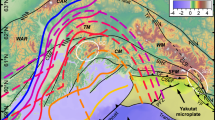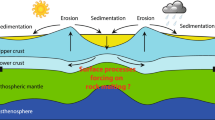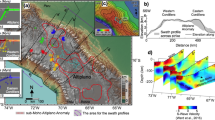Abstract
Active orogens are thought to behave as internally deforming critical-taper wedges that are in rough long-term equilibrium with tectonic influx and erosional outflux. Spatial and temporal variations in climate are therefore hypothesized to have a significant influence on denudation, topography and deformation of orogens, thereby affecting wedge taper. However, the impact of the most severe transition in Northern Hemisphere climate during the Cenozoic era—the onset of glaciation—has hitherto not been empirically documented. Here we analyse the spatial patterns of denudation and deformation, and their temporal variations, in the heavily glaciated St Elias orogen in southern Alaska. Low-temperature thermochronometry, thermokinematic modelling and offshore seismic reflection and borehole data suggest that the global-scale intensification of glaciation in the middle Pleistocene epoch enhanced glacier growth and caused ice streams to advance to the edge of the continental shelf. This led to focused denudation across the subaerial reaches of the orogen and burial of the actively deforming wedge toe by the eroded sediment. We propose that this climatically driven mass redistribution forced a structural reorganization of the orogen to maintain critical taper. Our empirical results thus support decades of numerical model predictions of orogenesis and provide compelling field evidence for the significant impact of climate change on tectonics.
This is a preview of subscription content, access via your institution
Access options
Subscribe to this journal
Receive 12 print issues and online access
$259.00 per year
only $21.58 per issue
Buy this article
- Purchase on Springer Link
- Instant access to full article PDF
Prices may be subject to local taxes which are calculated during checkout






Similar content being viewed by others
References
Molnar, P. & England, P. Late Cenozoic uplift of mountain ranges and global climate change: Chicken or egg? Nature 346, 29–34 (1990).
Lamb, S. & Davis, P. Cenozoic climate change as a possible cause for rise of the Andes. Nature 425, 792–797 (2003).
Huntington, K. W., Blythe, A. E. & Hodges, K. V. Climate change and Late Pliocene acceleration of erosion in the Himalaya. Earth Planet. Sci. Lett. 252, 107–118 (2006).
Tomkin, J. H. & Roe, G. H. Climate and tectonic controls on glaciated critical-taper orogens. Earth Planet. Sci. 262, 385–397 (2007).
Koons, P. O. Two-sided orogen: Collision and erosion from the sandbox to the Southern Alps, New Zealand. Geology 18, 679–682 (1990).
Beaumont, C., Fullsack, P. & Hamilton, J. in Thrust Tectonics (ed. McClay, K.) 1–18 (Chapman and Hall, 1992).
Willett, S. D. Orogeny and orography; the effects of erosion on the structure of mountain belts. J. Geophys. Res 104, 28957–28982 (1999).
Whipple, K. X. & Meade, B. J. Controls on the strength of coupling among climate, erosion, and deformation in two-sided, frictional orogenic wedges at steady state. J. Geophys. Res. 109, F01011 (2004).
Stolar, D. B. et al. Tectonics, climate, and landscape evolution. Geol. Soc. Am. Spec. Pap. 398, 241–250 (2006).
Davis, D., Suppe, J. & Dahlen, F. A. Mechanics of fold-and-thrust belts and accretionary wedges. J. Geophys. Res. 88, 1153–1172 (1983).
Dahlen, F. A., Suppe, J. & Davis, D. Mechanics of fold-and-thrust belts and accretionary wedges; cohesive Coulomb theory. J. Geophys. Res. 89, 10,087–10,101 (1984).
Brocklehurst, S. H. & Whipple, K. X. Glacial erosion and relief production in the Eastern Sierra Nevada, California. Geomorphology 42, 1–24 (2002).
Montgomery, D. R. Valley formation by fluvial and glacial erosion. Geology 30, 1047–1050 (2002).
Tomkin, J. H. Coupling glacial erosion and tectonics at active orogens: A numerical modeling study. J. Geophys. Res.-Earth Surf. 112, F02015 (2007).
Plafker, G., Moore, J. C. & Winkler, G. R. in The Geology of Alaska: Geological Society of America, Geology of North America, G-1 (eds Plafker, G. & Berg, H. C.) 389–449 (Boulder, 1994).
O’Sullivan, P. B. & Currie, L. D. Thermotectonic history of Mt Logan, Yukon Territory, Canada: Implications of multiple episodes of middle to late Cenozoic. Earth Planet. Sci. Lett. 144, 251–261 (1996).
Bruhn, R. L., Pavlis, T., Plafker, G. & Serpa, L. Deformation during terrane accretion in the Saint Elias orogen, Alaska. Geol. Soc. Am. Bull. 116, 771–787 (2004).
Pavlis, G. L., Picornell, C., Serpa, L., Bruhn, R. L. & Plafker, G. Tectonic processes during oblique collision: Insights from the St. Elias orogen, northern North American Cordillera. Tectonics 23, 1–14 (2004).
Fletcher, H. J. & Freymueller, J. T. New constraints on the motion of the Fairweather fault. Alaska, from GPS observations. Geophys. Res. Lett. 30, 1139–1142 (2003).
Elliott, J., Freymueller, J. T. & Larsen, C. F. Using GPS to untangle the tectonics of the Saint Elias orogen, Alaska. Eos Trans. (AGU 87 (52) Fall Meet. Suppl., Abstract G42A-03 2006).
Péwé, T. L. Quaternary geology of Alaska. US Geol. Survey Professional Paper 835, 145 (1975).
Berger, A. L. & Spotila, J. A. Denudation and deformation in a glaciated orogenic wedge: The St. Elias Orogen, Alaska. Geology 36, 523–526 (2008).
Rea, D. K. & Snoeckx, H. in Proc. Ocean Drilling Program, Scientific Results: Ocean Drilling Program (eds Rea, D. K., Basov, I. A., Scholl, D. W. & Allan, J. F.) 247–256 (College Station, 1995).
Lagoe, M. B. & Zellers, S. D. Depositional and microfaunal response to Pliocene climate change and tectonics in the eastern Gulf of Alaska. Mar. Micropaleontol. 27, 121–140 (1996).
Zachos, J., Pagani, M., Sloan, L., Thomas, E. & Billups, K. Trends, rhythms, and aberrations in global climate 65 Ma to present. Science 292, 686–693 (2001).
Lisiecki, L. E. & Raymo, M. E. A Pliocene-Pleistocene stack of 57 globally distributed benthic d18O records. Paleoceanography 20, PA1003 (2005).
Berger, W. H. & Jansen, E. The polar oceans and their role in shaping the global environment. AGU Geophys. Monogr. 84, 295–311 (1994).
Clark, P. U. et al. The middle Pleistocene transition: characteristics, mechanisms, and implications for long-term changes in atmospheric CO2 . Quat. Sci. Rev. 25, 3150–3184 (2006).
Cox, A. & Engebretson, D. C. Change in motion of Pacific plate at 5 Myr BP. Nature 313, 472–474 (1985).
DeMets, C., Gordon, R. G., Argus, D. F. & Stein, S. Effect of recent revisions of geomagnetic reversal time-scale on estimate of current plate motions. Geophys. Res. Lett. 21, 2191–2194 (1994).
Gulick, S., Lowe, L., Pavlis, T., Mayer, L. & Gardner, J. Geophysical insights into the Transition fault debate: Propagating strike-slip in response to stalling Yakutat block subduction in the Gulf of Alaska. Geology 35, 763–766 (2007).
Spotila, J. A., Buscher, J. T., Meigs, A. J. & Reiners, P. W. Long-term glacial erosion of active mountain belts: Example of the Chugach-St. Elias Range, Alaska. Geology 32, 501–504 (2004).
Berger, A. L. et al. Architecture, kinematics, and exhumation of a convergent orogenic wedge: A thermochronological investigation of tectonic-climatic interactions within the central St. Elias Orogen, Alaska. Earth Planet. Sci. Lett. 270, 13–24 (2008).
Andrews, J. T. Glacier power, mass balances, velocities, and erosion potential. Z. Geomorphol. N.F. Suppl. Bd. 13, 1–17 (1972).
Johnston, S. A. Geologic Structure and Exhumation Accompanying Yakutat Terrane Collision, Southern Alaska. M.S. thesis, Oregon State Univ. (2005).
Cundall, P. A. & Board, M. in Numerical Methods in Geomechanics (ed. Swoboda, G.) 2101–2108 (Balkema, 1989).
ITASCA, FLAC3D (Fast Lagrangian Analysis of Continua in 3 Dimensions, version 3.1), Minneapolis (2006).
Johnsson, M. J., Pawlewicz, M. J., Harris, A. G. & Valin, Z. C. Vitrinite reflectance and conodont color alteration index data from Alaska: Data to accompany the thermal maturity map of Alaska. US Geol. Surv. Open-File Report 92–409 (1992).
Johnsson, M. J. & Howell, D. G. Thermal maturity of sedimentary basins in Alaska: an overview. US Geol. Surv. Report B 2142, 1–9 (1996).
Sheaf, M. A., Serpa, L. & Pavlis, T. L. Exhumation rates in the St. Elias Mountains, Alaska. Tectonophysics 367, 1–11 (2003).
Ketcham, R. A. Forward and inverse modeling of low-temperature thermochronometry data. Rev. Mineral. Geochem. 58, 275–314 (2005).
Moore, M. A. & England, P. C. On the inference of denudation rates from cooling ages of minerals. Earth Planet. Sci. Lett. 185, 265–284 (2001).
Zellers, S. Foraminiferal sequence biostratigraphy and seismic stratigraphy of a tectonically active margin; the Yakataga formation, northeastern Gulf of Alaska. Mar. Micropaleontol. 26, 255–271 (1995).
Worthington, L., Gulick, S. & Pavlis, T. Identifying active structures in the Kayak and Pamplona Zones: Implications for offshore tectonics of the Yakutat microplate, Gulf of Alaska. AGU Monograph (in the press).
Kessler, M. A., Anderson, R. S. & Briner, J. P. Fjord insertion into continental margins driven by topographic steering of ice. Nature Geosci. 1, 365–369 (2008).
Powell, R. D. & Cooper, J. M. A glacial sequence stratigraphic model for temperate, glaciated continental shelves, in glacier-influenced sedimentation on high-latitude continental margins. Geol. Soc. Lond. Spec. Publ. 203, 215–244 (2002).
Acknowledgements
We thank collaborators in studying the St Elias orogen and other colleagues for many helpful discussions and ideas, including E. Berger, R. Law, J. Buscher and particularly all STEEP (St. Elias Erosion-Tectonics Project) participants. Reviews by S. Brocklehurst and E. Kirby contributed significantly to the manuscript. Support was provided by the National Science Foundation (NSF-EAR 0409224, NSF-EAR 0408584, NSF-EAR 0735402, NSF-ODP 0351620).
Author information
Authors and Affiliations
Contributions
All authors contributed to the interpretations and hypotheses presented. Writing was done by A.L.B., with contributions by J.A.S. and S.P.S.G. Low-temperature thermochronometry was carried out by A.L.B. and J.A.S. ArcGIS analyses were carried out by A.L.B. Thermokinematic modelling was carried out by P.U., with contributions by A.L.B. HeFTy age calculations were done by A.L.B. Figures were created by A.L.B (Figs 1–3 and 6), S.P.S.G. (Fig. 5) and P.U. (Fig. 4). Structural analysis and models were done by A.L.B., J.B.C. and T.L.P. Seismic reflection gathering, processing and interpretation were carried out by S.P.S.G., L.A.W., J.M.J. and B.A.W. Project planning was done by T.L.P., J.A.S. and S.P.S.G.
Corresponding authors
Supplementary information
Supplementary Information
Supplementary Information (PDF 550 kb)
Supplementary Information
Supplementary Movie (MOV 3351 kb)
Rights and permissions
About this article
Cite this article
Berger, A., Gulick, S., Spotila, J. et al. Quaternary tectonic response to intensified glacial erosion in an orogenic wedge. Nature Geosci 1, 793–799 (2008). https://doi.org/10.1038/ngeo334
Received:
Accepted:
Published:
Issue Date:
DOI: https://doi.org/10.1038/ngeo334
This article is cited by
-
The impact of glaciers on mountain erosion
Nature Reviews Earth & Environment (2021)
-
The provenance signal of climate–tectonic interactions in the evolving St. Elias orogen: framework component analysis and pyroxene and epidote single grain geochemistry of sediments from IODP 341 sites U1417 and U1418
International Journal of Earth Sciences (2021)
-
Sediment controls dynamic behavior of a Cordilleran Ice Stream at the Last Glacial Maximum
Nature Communications (2020)
-
Worldwide acceleration of mountain erosion under a cooling climate
Nature (2013)
-
Significant increase in relief of the European Alps during mid-Pleistocene glaciations
Nature Geoscience (2011)



